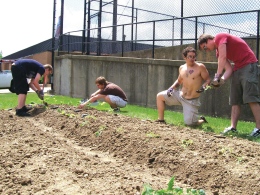
Student leaders, environmental advocates and campus food services say campus gardens could provide locally grown, fresh foods. However, campus officials haven’t been approached about creating new gardens, and some groups are finding it difficult to maintain the two that exist on campus.
Junior Elizabeth Widomski is a member of YSU’s Food and Nutrition Students. She applauds the benefits of locally grown food, but, like many others, said school, work and other volunteer activities would prevent her from helping out.
Staffing is an issue that has hindered gardens across campus.
Jenny Jacobs first started the garden across from the Student Health Clinic in Kilcawley House as a project in 2009 for a sustainable living course.
The garden, about 20 feet long and 8 feet wide, was taken over by members of the Youngstown Environmental Sustainability Society. Derek Scott, president of the YESS, and Felicia Armstrong, assistant professor of geological and environmental sciences, worked in the garden.
“I think we’re very lucky at Youngstown State University because we have such a beautiful campus,” said Elyse Gessler, president of the Student Government Association. “But allowing students to have a space where they can plant flowers, herbs, vegetables would even further connect them to their campus landscape, and, in return, would even create a further sense of pride in their university.”
Edward Krol, executive chef of dining services, agreed.
“We’re always looking for ways to be more sustainable, and we’re always looking to work with a campus garden to promote locally grown food within our dining halls,” Krol said.
But the gardens, Krol and others say, have seen better days.
“We are working to renew this effort and get back to using locally grown food on campus,” Krol said.
Scott and Armstrong have reached out to members of the biology department to help maintain the gardens.
Scott said he hopes the garden will grow and gain the attention of many YSU students.
“I hope people notice it on campus when walking behind Kilcawley or to the Kilcawley dorms, and that people realize we need not depend on large scale department stores and grocery stores for our food — which we don’t even know where it comes from or what chemicals have or have not been put on it,” Scott said. “It saves a lot of money if we all grew our own greens and vegetables, and it would be much healthier.”
The Rich Center for Autism has the second garden on the YSU campus — a healing garden; while it does not provide a harvest in autumn, its purpose is to make people feel better or at ease.
Savannah O’Brien, a student who works at the Rich Center, said new flowers are planted each spring and that many of their plants are annuals.
Recently, the Campus Beautification Working Group was asked to recommend landscaping ideas for the land where the Thompson-Sacherman House stood.
The CBWG asked Carol Sacherman, owner of the Thompson-Sacherman House, to attend a meeting and to give ideas about what to do with the land between the Beat Coffee House and Inner Circle Pizza.
Sacherman said she initially wanted to plant a garden filled with species native to the Youngstown area.
“Once native species are established, they strive,” Sacherman said.
Sacherman was upset with the land and lack of garden possibilities.
“It’s a little desert,” Sacherman said.
Dave Ewing, associate director of grounds, added that, along with irrigation, animal infestation could also be an issue in a shaded area.